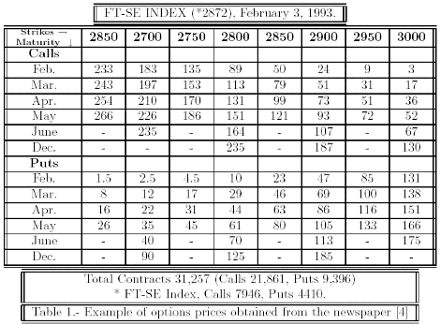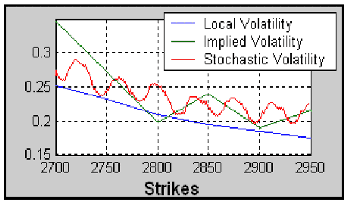We can estimate the market view using the volatility which is implied by the market prices. Using real data from the market, we can simulate the asset price path with its corresponding implied, local and stochastic volatility. Questions?
• How useful is it?
• Can we take advantage of this information to obtain a more accurate price for an exotic option and have a better understanding of hedging?
Local Volatility (Dupire Equation)
Given prices of call or put options across all strikes and maturities, we may deduce the volatility which produces those prices via the full Black-Scholes- Merton equation. (Dupire and Derman & Kani, 1994). In 1994, Dupire showed that if the spot price follows a risk-neutral random walk and if no-arbitrage market prices for European vanilla options are available for all strikes K and expiries T, then the local volatility can be extracted analytically from European option prices.
Problems arising from the use of the Dupire Equation:
One potential difficulty is that for strikes far in- or out-the-money the numerator and denominator of this equation may become very small, which could lead to numerical inaccuracies. Exchange traded options (market data) provide prices only at a limited, discrete set of strikes and maturities.
Stochastic Volatility (Heston Model)
The aim with a stochastic volatility model is to incorporate the empirical observation that volatility appears not to be constant and indeed varies, at least in part, randomly. The idea is to make the volatility itself a stochastic process.
Problems arising from the use of the Heston Model:
The Heston Model uses the square root of the volatility in its equation, so at some point, the model can give results as imaginary numbers. How can we fix the Heston parameters to adapt the “Stochastic Heston Model” to the market data ?
Using real market data obtained from newspapers, banks, television, the Internet (www.londonstockexchange.com), etc., such as the FTSE-100, Dow Jones, Nikkei or Dax, we can estimate the market view using the volatility ”σ” which is implied by the market prices. Looking at the traded options section of the Financial Times of 4 February 1993 (Table-1), we can get the options prices from the FT-SE INDEX.

Using this real data, we can estimate (simulate) the future asset price path with its corresponding implied, local and stochastic volatility.

Prof. Klaus Schmitz
Next: Implied Volatility
Summary: Index